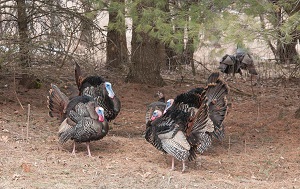
A preliminary report from Vermont Fish & Wildlife shows that hunters brought home 5,349 wild turkeys during the spring hunting season, including 571 turkeys taken during the April youth weekend hunt.
“Although this year’s results represent a modest decrease in harvest from those observed over the past few record setting years, the harvest was only slightly below the average harvest of the past ten years,” said Vermont Fish and Wildlife turkey biologist Chris Bernier.
“The prolonged cold and wet conditions experienced during the season likely contributed to the decline. Low production of turkey poults in 2017 due to harsh spring weather also likely resulted in fewer two-year old gobblers this past spring.”
Hunter success rates remained high with 23 percent of resident hunters taking birds, and 35 percent of those successful hunters harvested a second bearded bird to fill the two-bird spring bag limit.
“The 5,349 turkeys represent an estimated 122,000 servings of locally sourced, organic wild turkey meat as well as countless memories and an enduring connection to the land,” added Bernier.
Turkeys were hunted statewide and were harvested in 240 of Vermont’s 253 towns. The northern Lake Champlain Valley and the Connecticut River Valley continued to be productive regions for turkey hunters with the highest harvests again recorded in these parts of the state.
Vermont continues to prioritize high quality spring turkey hunting over fall turkey hunting opportunities. “This strategy certainly helped us sustain an abundant turkey population and realize a successful spring season despite the shortage of beechnuts and acorns we experienced last fall and the challenging winter and spring weather turkeys faced,” said Bernier.
“Vermont’s long history of careful and considerate management of wild turkeys has positioned us to maximize the benefits we all receive from this remarkable bird. Beyond the simple enjoyment and sustenance people get from watching and hunting wild turkeys, these birds play a critical role in the environment as an important prey item and influence the populations of many other species.”
Conservation of wild turkey habitat continues to play a key role in the health and vitality of their population. Bernier notes that a patchwork of fields and forests provide most of what a turkey needs to survive. He says the efforts to protect and manage habitat by private landowners, volunteer-based conservation groups like the National Wild Turkey Federation, and state and NGO conservation organizations will help ensure Vermont has a sustainable and abundant wild turkey population for the future.
For Immediate Release: July 25, 2019
Media Contacts: Chris Bernier 802-289-0628, Mark Scott 802-777-4217
